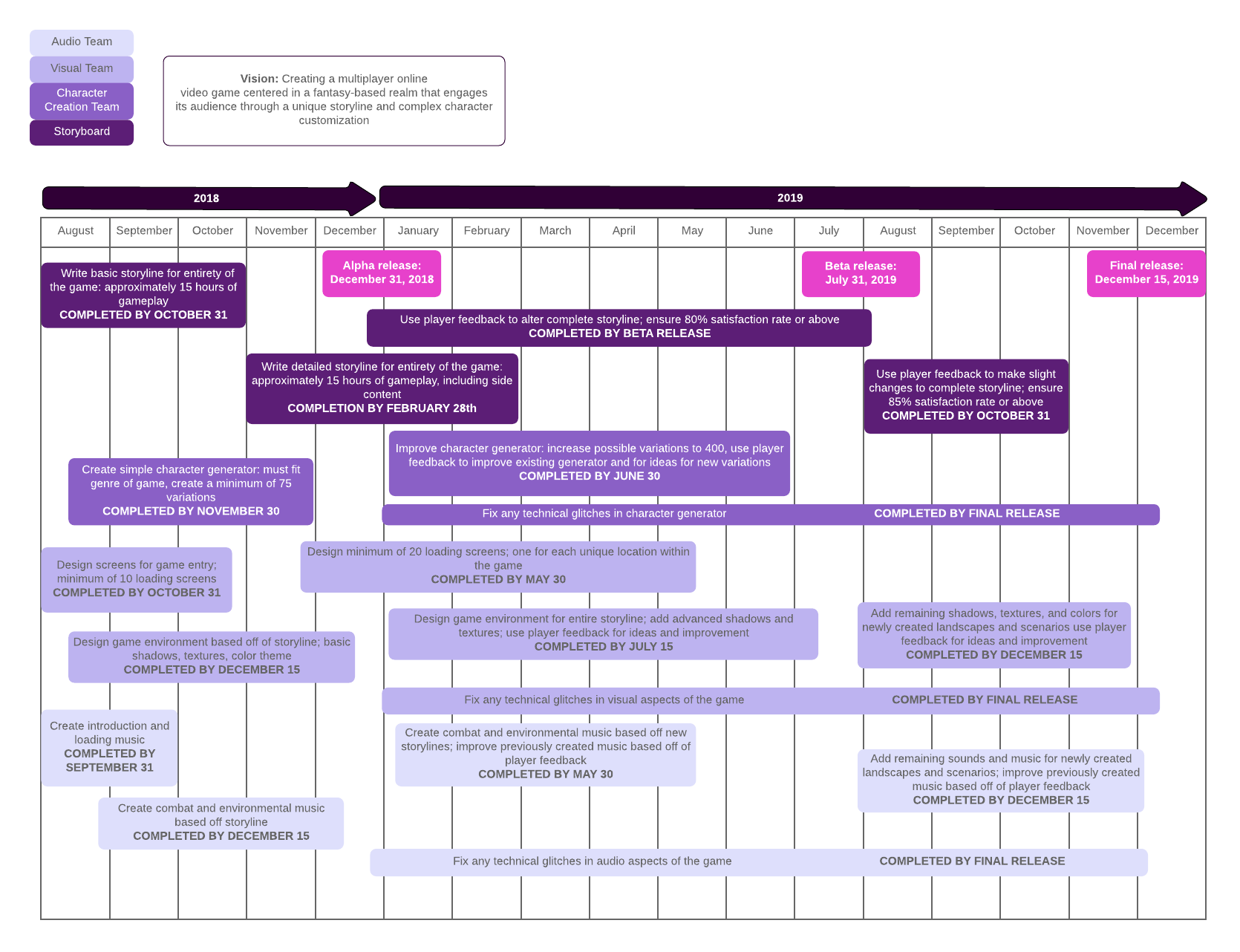
How to create an Agile release plan
Lucid Content
Reading time: about 6 min
The foundation of a successful project is a well-laid plan. An Agile release plan acts as a project’s map, providing context and direction on product goals, vision, and expectations. According to a report published by PMI, the most common factor in project failure was a lack of clearly defined goals, so for product managers, nailing the planning stage is crucial.
But too often, product managers and their teams get bogged down in clunky software, time-consuming meetings, and disparate data collections, resulting in miscommunication, wasted time, and inefficient resource allocation.
Under these circumstances, it’s obvious how so many projects lack focus and clarity. At best, these ingredients create a recipe for frustration and headaches; at worst, product releases may come in over budget, over time, and underperformed.
So how can product managers incorporate Scrum release planning to set their team up for success? We’ll walk you through the elements of a successful product release map.

What is Agile release planning?
Agile release planning is an approach to product management that takes into account the intangible and flexible nature of software development—as part of this approach, teams plan iterative sprints across incremental releases.
In other words, instead of trying to develop every proposed feature in one large, regimented project, the Agile software development life cycle breaks down the development process into stages called releases. In this context, releases are essentially periods of time set apart to work on a limited scope of the overall project. An Agile release plan maps out how and when features (or functionality) will be released and delivered to users.
By scheduling a project into Agile releases, product managers can better manage project constraints and adapt to evolving needs or challenges that arise through the development stage while regularly producing product deliverables for the end user.
Elements of a product release map
Despite its name, Agile release planning is highly structured. Each step is carefully outlined and measured to create high-level project calendars for teams to follow.
Release maps will vary slightly between organizations, but the general elements will include:
- The proposed release(s) for the project
- Plans for each release
- Subsequent iterations for the release(s)
- Plans for each iteration
- Feature development within an iteration
- Individual tasks necessary to deliver a feature
This level of planning, combined with an iterative schedule to account for the dynamic nature of software, is what makes Agile product development so valuable.
The iterative release schedule gives teams the space to make course corrections without derailing the entire project, while the detailed roadmap and focus on the planning stage ensure everyone is on the same page.
How to create an Agile release plan
To create a successful Scrum release plan, you’ll follow four basic steps.
Step 1: Define your vision
One of the most important steps in the planning process is defining the vision for your product. The vision will guide subsequent decisions on which features to prioritize, where to focus effort and resources, and how to adapt if the project requires adjustment during development.
You may need to consult with executives or other high-level stakeholders to ensure your vision aligns with both the market and the organization’s overall objectives.
Step 2: Rank the product backlog
Next, you will need to review your product backlog and rank the features. Use the product vision as well as input from stakeholders to determine product priorities and map out user stories. User stories are user-centered descriptions of the proposed functionality (or feature).
During this step, the product manager should outline a basic Scrum release plan or roadmap that includes the release goal, release target date, and the ranked user stories.
Step 3: Hold a release planning meeting
Once the overall product vision and release map are outlined, it’s time to gather all stakeholders together in a Scrum release planning meeting to review the proposed plan, add to or edit the plan as needed, and align on the product deliverables.
This step ensures everyone is on the same page regarding strategy and collaboration before diving into the project.
Haven't created a product roadmap yet? Learn how to build one and articulate your company's long-term vision.
Read moreA basic agenda will include the following actions.
Review roadmap
The first item on the meeting agenda is to review the vision and product roadmap to confirm that everyone understands the overall goal for the product.
Review architecture
Next, stakeholders should review the architecture and technical details for the release. This is the time to discuss any new information that could affect the release plan estimates and scope, including dependencies, assumptions, or gaps.
Review velocity and iteration schedule
Present the estimated velocity—typically based on previous projects or iterations—along with the proposed iteration schedule.
Each user story is assigned points based on how much effort or work is required to complete associated tasks. The product manager calculates the velocity by adding all user story points within a sprint (or release). The result is a reasonable estimate of how quickly the team could complete that iteration. From there, you can outline an iteration schedule based on the scrum team’s velocity.
The iteration schedule essentially outlines how much work will be included in a particular release (i.e., the release scope) and how the work will be distributed across the team. Review key milestones and events and confirm the schedule as a group.
Establish the “Definition of Done” for the release
As a group, review and decide on the “Definition of Done” for any given release. In other words, what are the acceptance criteria across all user stories in the release?
When all conditions are met, the team can confirm a release is completed. The “Definition of Done” usually means the team has completed every task outlined under a user story and documented the work for the product owner to review.
Step 4: Finalize and share product release calendar
Following the planning meeting, finalize details, make any last adjustments, and then share the product release calendar with all stakeholders. Everyone should have ongoing access to the release plan for reference and updates. The Scrum release plan will help the team stay focused on the right tasks at the right time.
Because Agile release plans have such a significant impact on the future success of a project, it is important to create clear timelines and process flows that all stakeholders can access. Use a visual workspace like Lucidchart to craft informative and clear Scrum release plans for more efficient and effective development. Managers, team members, and other stakeholders can view plans and project details in real time, so nothing gets lost in the shuffle.

Learn how you can use Lucidchart to successfully implement Agile methodology.
Read moreAbout Lucidchart
Lucidchart, a cloud-based intelligent diagramming application, is a core component of Lucid Software's Visual Collaboration Suite. This intuitive, cloud-based solution empowers teams to collaborate in real-time to build flowcharts, mockups, UML diagrams, customer journey maps, and more. Lucidchart propels teams forward to build the future faster. Lucid is proud to serve top businesses around the world, including customers such as Google, GE, and NBC Universal, and 99% of the Fortune 500. Lucid partners with industry leaders, including Google, Atlassian, and Microsoft. Since its founding, Lucid has received numerous awards for its products, business, and workplace culture. For more information, visit lucidchart.com.
Related articles
What is Agile methodology? (+ how you're already using it)
Learn about Agile methodology and the ways you can apply these principles as a product manager. Template examples of Agile frameworks included!
The Stages of the Agile Software Development Life Cycle
Learn the stages involved in the agile software development life cycle (SDLC) to determine whether this process will fit your team’s needs.
